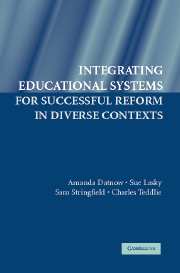Book contents
- Frontmatter
- Contents
- List of Figures and Tables
- Acknowledgments
- 1 Introduction
- 2 School Effectiveness and Improvement
- 3 District-Level Reform Efforts
- 4 Community-Level Reform Efforts
- 5 State-Level Reform Efforts
- 6 The Role of Reform Design Teams
- 7 The Role of the Federal Government in Reform Efforts
- 8 Methodological Issues in the Study of Systemic Integration for Effective Reform
- 9 Discussion and Conclusion
- Bibliography
- Index
4 - Community-Level Reform Efforts
Published online by Cambridge University Press: 02 September 2009
- Frontmatter
- Contents
- List of Figures and Tables
- Acknowledgments
- 1 Introduction
- 2 School Effectiveness and Improvement
- 3 District-Level Reform Efforts
- 4 Community-Level Reform Efforts
- 5 State-Level Reform Efforts
- 6 The Role of Reform Design Teams
- 7 The Role of the Federal Government in Reform Efforts
- 8 Methodological Issues in the Study of Systemic Integration for Effective Reform
- 9 Discussion and Conclusion
- Bibliography
- Index
Summary
O'Day and Smith (1993) wrote that it takes a combination of improved social conditions and additional educational resources to close the achievement gap between white and poor minority youth. The research studies discussed in this chapter return to the relationship between community capacity and student achievement and the role of the community in reform efforts. They expand and complicate the discussion of urban and rural school reform by bringing to the forefront elements of (a) language (Hamann 2002; Tharp et al. 2000); (b) race (Henig et al. 1999; Horn 2000a; Rich 1996; Stone 1998a); (c) economic (Horn 2000b; Rich 1996) and civic capacity (Stone et al. 2001); and (d) the politics inherent in education reform (Hess 1999; Hill et al. 2000). In this section, the authors we cite stress the importance of considering different dimensions of a locale's political context and the linkages between various governmental agencies and community businesses, organizations, and groups when studying school reform. For several of these researchers, school reform cannot be separated from the social reconstruction of urban centers (Anyon 1997; Henig et al. 1999; Rich 1996; Stone 1998b), or from the economic challenges that poor, isolated rural communities face (Horn 2000a, 2000b).
Figure 4 helps to orient the role of the community in our framework.
In this chapter, we separately address the issues faced by educators in high-poverty rural contexts and high-poverty urban contexts.
- Type
- Chapter
- Information
- Publisher: Cambridge University PressPrint publication year: 2006

